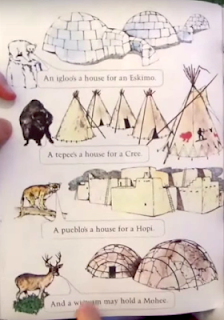Gooney Bird Greene likes to be right smack in the middle of everything. That's why she wants to have the lead role of Squanto in her class Thanksgiving pageant. But that role will go to whoever finds someone to be the room mother. All the parents are so busy, no one can bring cupcakes to the play. Gooney Bird Greene to the rescue! She finds a room mother alright, but promises not to tell who it is until the day of the play. Now the kids are really busy getting ready for the show. But will the mystery room mother really show up?
Debbie's comments: That illustration with kids in those hats and headbands appears four times in the book. I see that in many children's books and in many photos teachers share of their own classroom activities around the holiday. Lowry's book joins the pile of educationally bad children's books that get circulated in society. It miseducates every child who learns this is ok.
Succotash, succotash, lima beans and corn. Thank you, noble Squanto, you may set the platter down.
"I decided Squanto should have a better hat than the other Native Americans, because he's been to England, remember?"
"Well, yes, he did travel there. But that's a top hat, Gooney Bird. Something an ambassador might wear. I don't think---"
"I think Squanto brought it back from England. He probably went shopping and bought a lot of new clothes there. People always buy new clothes when they travel."
"I'm sorry that I was depressed for a minute. It's just that the story of the first Thanksgiving is such a truly wonderful story, about becoming friends, and helping one another, and being thankful. I wish I could have presented it better, instead of writing a dumb song about succotash."
I am not the actual Squanto. The real Squanto was a Patuxet Indian who was born in a village near where the Pilgrims would land, but when he was born they hadn't landed yet.
He learned to speak English from some early settlers. He helped them in many ways. He was a very helpful guy.
When some of them went back to England, they invited him to go along. His mother didn't want him to.
But he went anyway. This was way back in the 1600s. Squanto is dead now. I am not the real Squanto. I am an imitation.
He traveled around for a while, being helpful because he was a helpful guy. He was an interpreter between the Americans and the Indians.
But suddenly--a bad ship captain tricked him into going onto his ship. It was a big scam. They made him a captive and took him to Spain. The captives all were sold as slaves. It made Squanto pretty mad.
But he was indefatigable.
After a long time Squanto finally made his way home. He had been away for years. And when he finally got home, he found that his village was gone. His people had all died. He was the last of his tribe.
It was very sad. But he became friends with the great chief Massasoit, and after a while he met the Pilgrims, who had just arrived. So he had some new friends and they hung out together.
The Pilgrims' lives in America would have been a fiasco if good Indians like Squanto had not helped them.
Squanto had gotten lots of new clothes in England, and he had learned to dance.
The End.
"All of my story was absolutely true, except maybe the part about learning to dance, but I think he probably did."


































